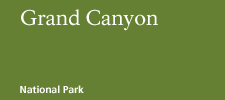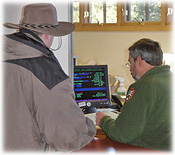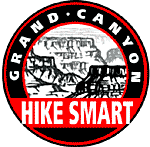Fees
There is a non-refundable fee of $10 per permit plus $5 per person per night camped below the rim and $5 per group per night camped above the rim. Frequent users may wish to purchase a one-year Frequent Hiker membership for $25 that waives the initial $10 fee for each permit obtained by the trip leader for twelve months from the date of purchase.
When sending in a permit request, the preferred method of payment is with a credit card. Please be sure to indicate the maximum amount you authorize the Backcountry Information Center to charge so that your longest trip alternative can be considered. Valid personal checks and money orders against a United States bank are also accepted when made out for the correct amount. Please do not send cash in the mail.
Permit holders will be responsible for paying park entrance fees upon arrival.
South Bass Trail and Pasture Wash Trail visitors may be charged an additional fee by the tribe for crossing the Havasupai Indian Reservation.
How to Apply
Obtain and fill out the Backcountry Permit Request Form:
Having difficulties opening the Backcountry Permit Request Form or the Use Area Map? You must have Adobe Reader version 7 or newer (as of Jan 2011 the current version of Adobe Reader is 10). Get the newest version of the free Adobe Reader.
Do not forget to include the following with your permit request:
- Trip leader's name, address, and telephone number.
- Credit card number, expiration date, signature, date signed, and largest amount you authorize the National Park Service to charge.
- Number of people and/or stock in the group (see Private Stock).
- License plate numbers of any cars to be left at the trailhead.
- Proposed night-by-night itinerary showing use area codes and dates for each night
- Organization name if applicable (see Group Size and Commercial Use below).
- Alternative proposed itineraries.
Submit the permit request form in one of the following ways:
- Bring request to the Backcountry Information Center.
- Fax request to the Backcountry Information Center, 928-638-2125.
NOTE: You can send a fax 24 hours a day, 7 days a week, 365 days a year - HOWEVER the first day of every month we receive many faxes and the number may be busy.
- Mail request to Backcountry Information Center / GCNP, P.O. Box 129, Grand Canyon AZ, 86023.
Permit requests are not accepted by telephone or by email.
When to Apply
The furthest in advance permit requests are accepted and considered by the Backcountry Information Center is the first of the month, four months prior to the proposed start month.
To obtain a backcountry permit for the dates and use areas/campsites of your choice, ensure your request arrives at the Backcountry Information Center on the first day it will be accepted (but not before). Faxing is strongly recommended. Popular use areas/campsites fill up the first week of the first month they become available for permit requests.
Only written requests are accepted during the fourth-month-out. Written requests may be submitted by fax, by letter, or by hand delivery. Regardless of how they are submitted, written requests will be considered based on the date on which they are received, and all of the requests received by 5:00 p.m. on the first day of the fourth-month-out will be placed in random order by computer and considered in that new order before the next day’s requests receive consideration.
Verbal in-person permit requests are only considered for start dates one to three months out.
| For hike dates during the month of: |
Submit written permit requests on or after: |
In-person verbal requests accepted on or after: |
| January |
September 1 |
October 1 |
| February |
October 1 |
November 1 |
| March |
November 1 |
December 1 |
| April |
December 1 |
January 1 |
| May |
January 1 |
February 1 |
| June |
February 1 |
March 1 |
| July |
March 1 |
April 1 |
| August |
April 1 |
May 1 |
| September |
May 1 |
June 1 |
| October |
June 1 |
July 1 |
| November |
July 1 |
August 1 |
| December |
August 1 |
September 1 |
Mailed requests must be postmarked no earlier than than the date indicated on the chart. Faxed requests must not be received earlier than the date indicated on the chart above.
Operational changes were made on February 1, 2010 to backcountry permitting procedures. Additional information can be found at www.nps.gov/grca/planyourvisit/permit_change.htm
Permit Responses
Permit requests are responded to through U.S. Mail - never by fax or e-mail. Due to the volume of requests received, the park cannot confirm receipt of requests until they have been fully processed. Please allow at least three weeks for processing.
When space is available and all fee requirements are met, a permit will be issued and mailed to the trip leader. The permit is valid only for the trip leader named on the permit. Overnight hikers are not permitted to enter the canyon without a valid permit in the trip leader's possession.
If you have been denied a permit through the mail, you may want to consider day hikes or attempt to obtain a last minute, walk-in permit.
Last Minute Permit for Corridor Campgrounds
A limited number of last minute walk-up permits are available at the Backcountry Information Center for Corridor Campgrounds (Indian Garden, Bright Angel, and Cottonwood Campgrounds). These permits are issued in person only, are for one or two consecutive nights, and cannot be purchased more than one day prior to the start of a hike.
Waitlist
You can stop by the Backcountry Information Center at any time during open hours and request a waitlist number. This number is valid for the following morning and will be used to determine priority of service. At 8:00 a.m. Backcountry Information Center staff will call waitlist numbers. When your turn comes you can request a permit, exchange your number for a new waitlist number good for the following day, or simply ask questions. You may participate in the waitlist for as many consecutive days as is convenient.
Following is an example showing how the waitlist can be used to secure a lower number for the next day and increase your chances of obtaining your desired permit.
Last minute permit and waitlist example:
- Day 1, Tuesday: You come to the Backcountry Information Center at 11 a.m. and request a permit for Bright Angel on Wednesday night and Indian Garden on Thursday night. No permits are available. You join the waitlist for the next day and are assigned #10.
- Day 2, Wednesday: You return at 7:55 a.m. Unfortunately by the time Backcountry Information Center staff reaches your waitlist number, all Corridor Campground permits have been assigned. You exchange today’s waitlist number for tomorrow’s waitlist number; you are #2.
- Day 3, Thursday: You return at 7:59 a.m. In a matter of 15 minutes you have a permit for Bright Angel on Friday night and Indian Garden on Saturday night, hiking out Sunday morning.
Use Areas
The backcountry is divided into "use areas". Each use area has an overnight capacity based upon the size of the area, the number of suitable and available campsites, its ecological sensitivity, its management zoning, and its use history. Use areas range in size from several hundred acres to several thousand acres.
Length of Stay
Camping in the Corridor, Hermit, Monument, Horseshoe Mesa, and Tapeats Use Areas is limited to designated campsites or campgrounds only. Camping in these designated campsites or campgrounds is limited to two nights (consecutive or non-consecutive) per campsite or campground per hike. One exception is made to this rule: from November 15-February 28, up to four nights will be allowed in popular corridor campgrounds.
Outside the use areas named above, "at-large" camping is permitted, meaning that camps are not limited to designated sites.
Trips are limited to a maximum of seven nights per use area; however, overall trip lengths are not limited.
Group Size
More permits are available for small groups (1-6 people) than for large groups (7-11 people). Because there are only a few large group sites, limiting the size of your group will increase your chances of obtaining a permit.
Larger groups tend to cause a disproportionately higher amount of damage to the canyon, largely due to the effects of "social" trailing. For this reason, the park's Backcountry Management Plan does not allow groups larger than eleven people to camp in the same campground or use area.
Regulations stipulate that all permits are void when a group obtains multiple permits for the same campground or use area for the same night. The alternative for these larger groups is to obtain permits for smaller groups and ensure the itineraries for these permits never bring more than one of the permits into the same campground or use area on the same night. No more than four large groups or eight small groups that are affiliated with each other may camp within the backcountry on the same night.
Commercial Use
In addition to following all normal backcountry permit requirements, commercial organizations must obtain a Commercial Use Authorization. Contact the park's Concession Management Office at (928) 638-7707 for further information or visit www.nps.gov/grca/parkmgmt/businesswithpark.htm
North Rim Winter Use
Winter use guidelines come into affect after the North Rim receives adequate snowfall to close Highway 67 or on Dec 1st, whichever comes first. Once in effect, winter use guidelines apply until mid-May, when the North Rim reopens for the season.
During the winter season a backcountry permit is required for overnight use of the North Rim from the park's northern boundary to Bright Angel Point on the canyon rim. Winter access is by hiking, snowshoeing, or cross-country skiing only. A permit can be obtained in advance at the Backcountry Information Center.
Permittees are allowed to camp at-large between the park's north boundary and the North Kaibab trailhead but not at the trailhead itself. Between the North Kaibab trailhead and the Bright Angel Point area, camping is permitted only at the North Rim Campground group campsite.
Human waste may not be buried in the snow in areas that will be in view of summer users.
Remote Sites
With a valid credit card, last minute permits may sometimes be obtained from rangers on duty at the Tuweep, Meadview, and Lees Ferry ranger stations for a limited number of use areas in their vicinities. However, these rangers have other patrol responsibilities and may not be available to provide assistance. It is recommended that all trips be planned well in advance through the Backcountry Information Center.
Pipe Spring National Monument near Fredonia, Arizona, and the Bureau of Land Management office in St. George, Utah have a similar arrangements for issuing remote site permits.
Backcountry Use Statistics
Backcountry use statistics (from overnight backcountry permits) can be found here. The statistics include:
- use trends (1998-2009) by year and month
- backcountry use breakdown by country and state
- permits issued to Grand Canyon Field Institute, Boy Scouts, and CUAs
- backcountry use by use area









